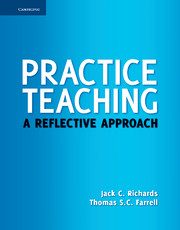Book contents
- Frontmatter
- Contents
- Introduction
- Chapter 1 Learning to Teach Through Practice Teaching
- Chapter 2 The Nature of Teacher Learning
- Chapter 3 Understanding the Teaching Context
- Chapter 4 Working With Your Cooperating Teacher
- Chapter 5 Planning Your Teaching
- Chapter 6 Teaching an Effective Language Lesson
- Chapter 7 Classroom Observation in Teaching Practice
- Chapter 8 Creating an Effective Classroom Learning Environment
- Chapter 9 Developing Learner-Centered Teaching
- Chapter 10 Classroom Discourse and Communication
- Chapter 11 Exploring Your Own Teaching
- Chapter 12 After Teaching Practice
- References
- Author Index
- Subject Index
Chapter 10 - Classroom Discourse and Communication
Published online by Cambridge University Press: 05 October 2012
- Frontmatter
- Contents
- Introduction
- Chapter 1 Learning to Teach Through Practice Teaching
- Chapter 2 The Nature of Teacher Learning
- Chapter 3 Understanding the Teaching Context
- Chapter 4 Working With Your Cooperating Teacher
- Chapter 5 Planning Your Teaching
- Chapter 6 Teaching an Effective Language Lesson
- Chapter 7 Classroom Observation in Teaching Practice
- Chapter 8 Creating an Effective Classroom Learning Environment
- Chapter 9 Developing Learner-Centered Teaching
- Chapter 10 Classroom Discourse and Communication
- Chapter 11 Exploring Your Own Teaching
- Chapter 12 After Teaching Practice
- References
- Author Index
- Subject Index
Summary
INTRODUCTION
Language is used in many different ways in second language classrooms since it is both the means and the end of learning. A crucial aspect of language classes, therefore, is the way in which teachers use language to support and manage the processes of language learning. The language input learners receive during a lesson and the opportunities it opens up for language practice and use are provided by the teacher, by the teaching resources he or she makes use of, and by the students' interactions with each other. Many observers of language classrooms have commented that in many classrooms, students have only restricted opportunities to participate in the communicative and interactive uses of language and hence have restricted opportunities for language learning (Thornbury 2005). In this chapter we want to explore the kinds of communication, interaction, and discourse that occur during the instructional phase of a lesson (rather than when the teacher is engaged in noninstructional activities, such as classroom management) and how they can be used to effectively support and guide second language learning.
THE NATURE OF INSTRUCTIONAL DISCOURSE
The nature of verbal interaction in second language classrooms shares some of the characteristics of verbal interaction in classrooms where other subjects are being taught. Both teachers of English as well as teachers of other subjects have to find ways of presenting new learning content in ways which engage learners, which make connections with previous learning, which present content at a comprehensible and learnable rate, and which provide opportunities for learners to master lesson content through processes such as analysis, reflection, application, and practice.
- Type
- Chapter
- Information
- Practice TeachingA Reflective Approach, pp. 134 - 149Publisher: Cambridge University PressPrint publication year: 2011



